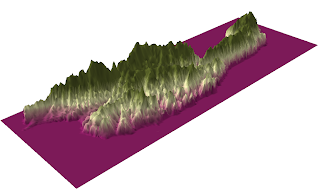In this final lab, we were asked to map Black population, Asian population and Some Other Race Alone in the United States using 2000 Census data from the U.S. Census Bureau. Each thematic map in this series is a chloropleth map, using 5 different classification colors and the Quantile classification system. Each map gives the race population that it maps in its Title and Subtitle, a legend showing the percent of the population corresponding to each color, and metadata (brief summary of the map's Datum, Projection and Source. Overall, we can see from this series of maps the unique demography of Black population, Asian population and Some Other Race Alone. Furthermore, it becomes evident that each portion of the population is most present in specific regions of the United States.
The first map (Fig. 1) shows Black alone population in the United States in 2000. From this map, we can see that a large number of the Black population is located in the Southern United States. This information is very helpful for policy makers, specifically in this case, for policy makers for the Southern states. We can also see in this map that the Black population is rather sparse in the North Mountain states of Montana, Wyoming, North and South Dakotas. This might tell users of this map about the history and culture of these regions, also about what types of decisions the policy makers in this region might be making which affect population.
 |
| Fig. 1 |
The second map (Fig. 2) shows Asian alone population in the United States in 2000. This map reveals that the Asian population in the United States is fairly spread out. There exists a large number of members of the Asian population on both the West and the East Coasts, specifically around Southern California, Southern Florida and the far North-East. This characteristic showing population location shows users of this map that policy makers in these regions of the United States are faced with making decisions that will affect the large Asian population of their county or state. This map will also help to inform policy makers of these regions about the percent of the population in their county that is a member of the United States' Asian population.
 |
| Fig. 2 |
The third map (Fig. 3) shows Some Other Race alone population in the United States in 2000. Some Other Race Alone means that the individual filling out the census marked 'Other' race instead of White, Black, Asian, Native American or Hispanic/Latino. This map shows that there is a great deal of diversity in terms of races not represented by the specific race categories offered by the U.S. Census in the Western and South-Western United States and less so in the South, North and Eastern United States. One reason for this could be that the regions where there is more diversity is because they are generally more newly developed regions of the United States, where perhaps diversity is more easily accepted.
 |
| Fig. 3 |
GIS is both extremely frustrating when it is not working smoothly for you, and extremely rewarding once you succeed at making a clear, accurate and interesting map. I am very happy that I took Geography 7 because I have certainly learned a valuable skill, and one that I will pursue further. I am enrolled in Intermediate GIS for Winter quarter and I plan on taking Advanced GIS in the Spring. While I believe that I have been exposed to a variety of the options available in ArcGIS, I know that there is much for me to learn. Part of what is necessary next for me to learn are specific techniques and how to execute them, and another part of it is simply becoming more acclimated to the software and continuing to practice with it.
I enjoyed how each lab focused on a different aspect of ArcGIS, honing in on a certain capability with the software and focusing on it. I think that my favorite lab exercise was Lab 7 : Mapping the LA Station Fire. I enjoyed this lab because there was lots of room for creativity and we learned the value technique of extracting information from a broader file, such as LA county from Counties in California or the Fire perimeter from LA County. I found those techniques to be very useful and interesting to incorporate with maps, especially in an inset map.
I enjoyed how each lab focused on a different aspect of ArcGIS, honing in on a certain capability with the software and focusing on it. I think that my favorite lab exercise was Lab 7 : Mapping the LA Station Fire. I enjoyed this lab because there was lots of room for creativity and we learned the value technique of extracting information from a broader file, such as LA county from Counties in California or the Fire perimeter from LA County. I found those techniques to be very useful and interesting to incorporate with maps, especially in an inset map.












